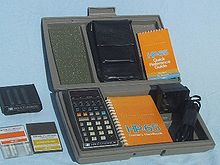HP-65

The HP-65 was the world's first programmable calculator . It has been built by Hewlett-Packard since 1974 .
The computer had 9 memory registers and program memory for 100 key commands. He also owned a magnetic card reader / writer whose cards were about the size of a stick of chewing gum. Like almost all subsequent HP calculators, it used reverse Polish notation (UPN) when entering numbers in order to be able to use memory more effectively. This system does not require a conventional = key, but instead has an Enter key to place operands on the four-level stack and operator keys to link them.
The HP-65 offered very few program editing functions and the memory register R9 was overwritten when the user e.g. B. performed a trigonometric function. But since this was documented in the manual, it was not an error, but shows how sparingly you had to use the storage space at the time.
Bill Hewlett's intention was for the calculator to fit in a shirt pocket. That is one of the reasons for the tapered shape of the pocket calculator. The magnetic stripe was inserted at the thick end of the calculator under the LED display.
The description of the programs for the HP-65 was very extensive and contained hundreds of applications from different areas such as solutions of differential equations, stock market price calculations or statistical programs. The HP-65 had many buyers and supporters, especially among engineers and scientists, but also among business people, professors, teachers and students.
In addition to the HP-65, Hewlett-Packard also manufactured a whole series of famous pocket calculators:
- HP-35 (first pocket calculator in the world with scientific functions)
- HP-01 (first wristwatch calculator)
- HP-55 (first programmable scientific calculator with quartz timer)
- HP-25 (Low Cost Programmable Scientific Calculator)
- HP-41C (first calculator with alphanumeric display)
- HP-12C (Best Selling Financial Calculator)
- HP-48 (successor to the HP-41 from 1989. Still available in an improved form as HP-49G + or HP-50G)
Trivia
- Due to its use in the Apollo-Soyuz project in 1975 , the HP-65 was the first programmable calculator in space .
- Mitchell Feigenbaum discovered the Feigenbaum constant named after him in 1975 with an HP-65.
- Steve Wozniak sold his HP-65 pocket calculator in 1976 in order to raise his share of the start-up capital of the Apple company .
- In the film "Computer morden leise" ( L'Ordinateur des pompes funèbres , 1976) the insurance clerk and statistician Fred Malone (played by Jean-Louis Trintignant ) plans the death of his wife and uses an HP-65 to calculate the most likely way of death.
Web links
- Description of the HP-65 - Museum of HP calculators
- HP-65 in the Hewlett-Packard Virtual Museum (English)
- HP-65 images on MyCalcDB.
Individual evidence
- ↑ HP-65 features. The Museum of HP Calculators, accessed June 26, 2016 .
- ↑ HP-35. The Museum of HP Calculators, accessed January 28, 2018 .
- ^ Isaacson, Walter: Steve Jobs. Little, Brown, London 2011 ISBN 978-1-4087-0374-8 , page 62

